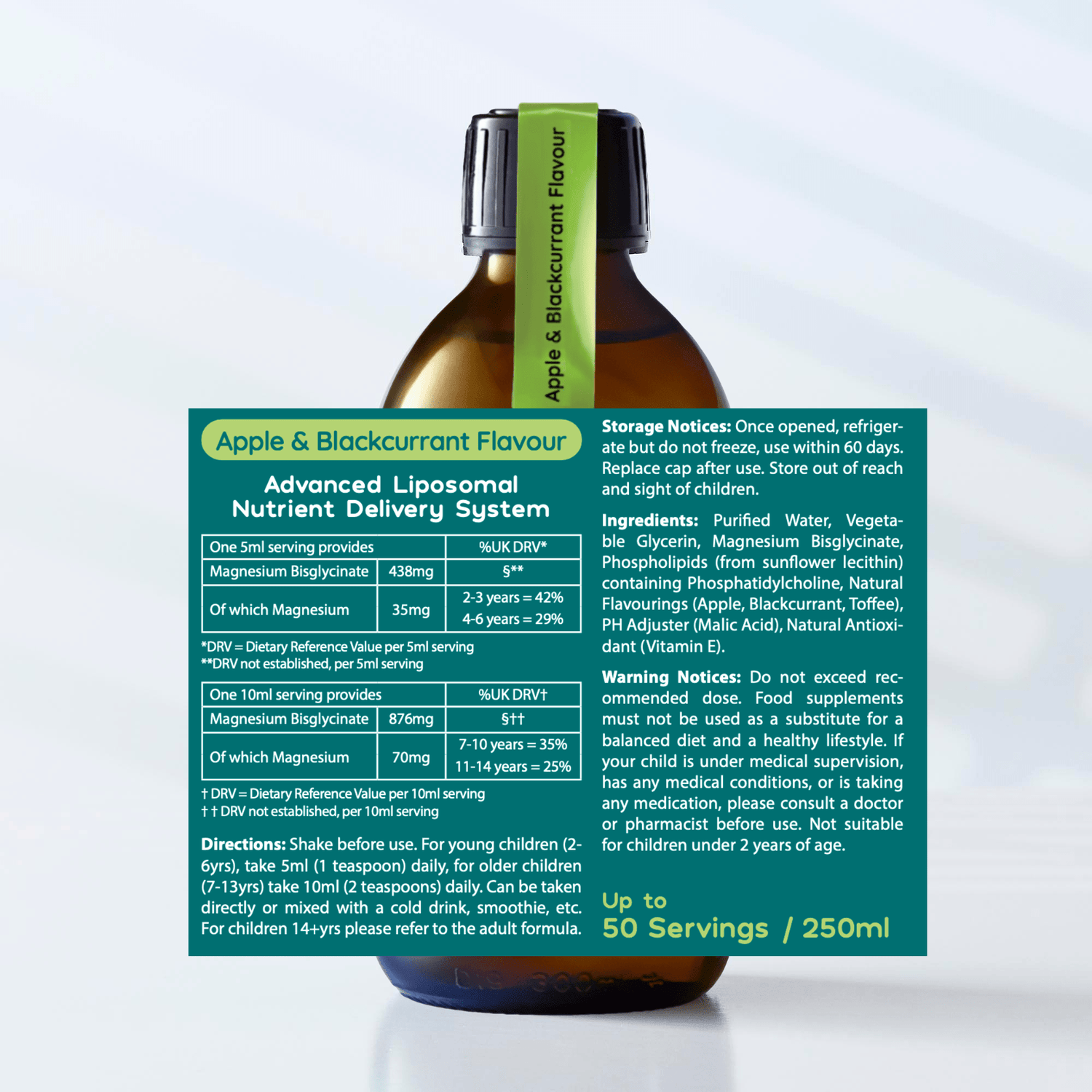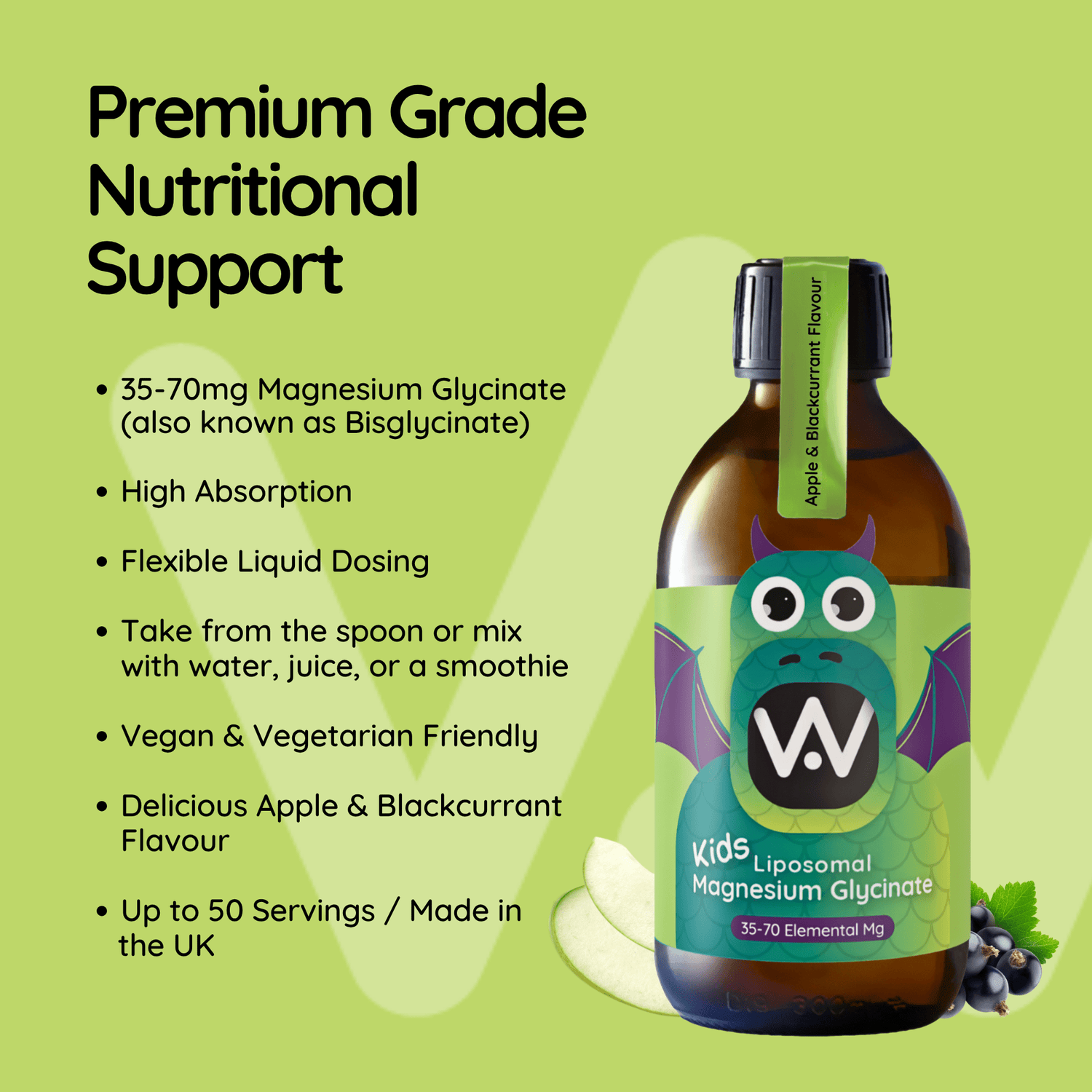
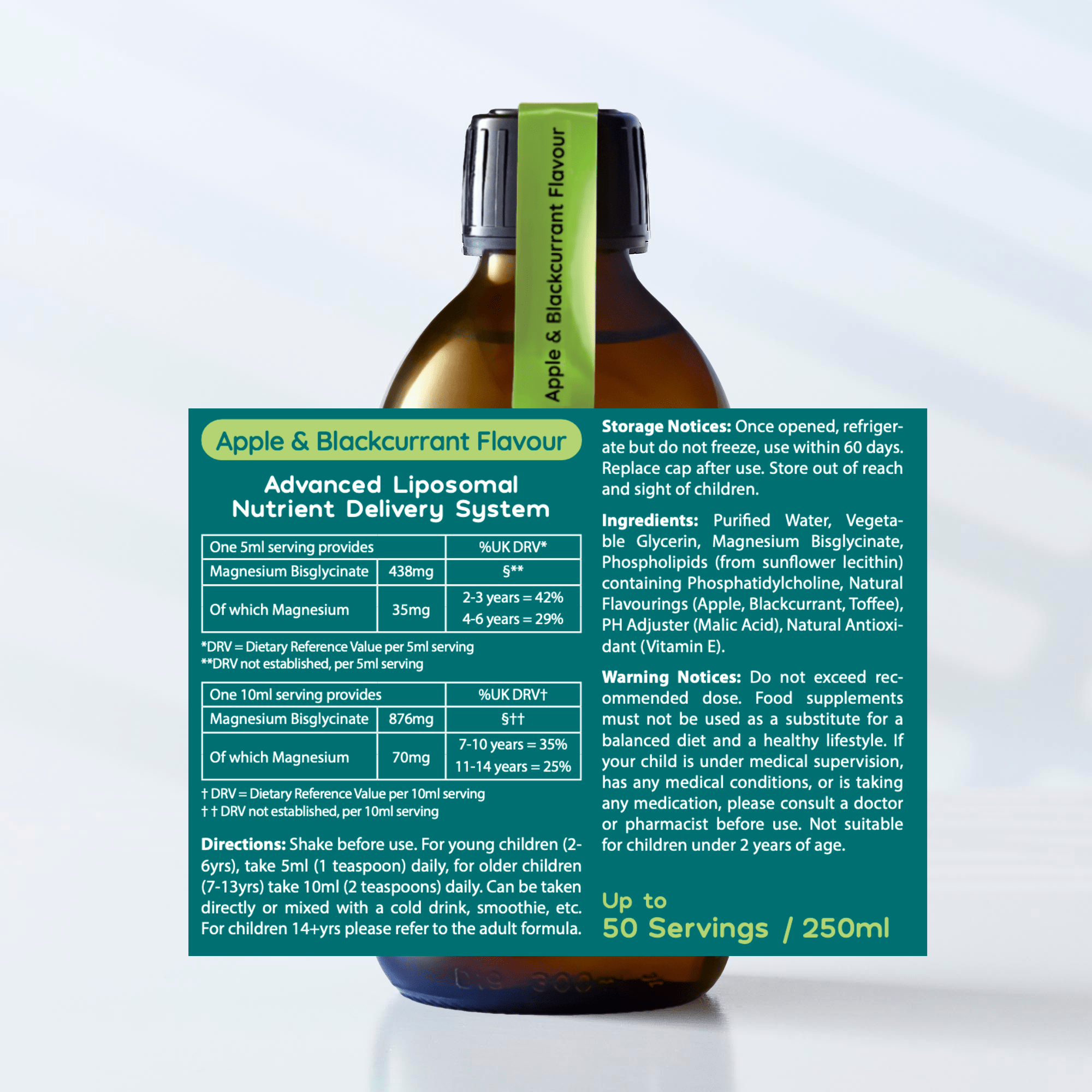
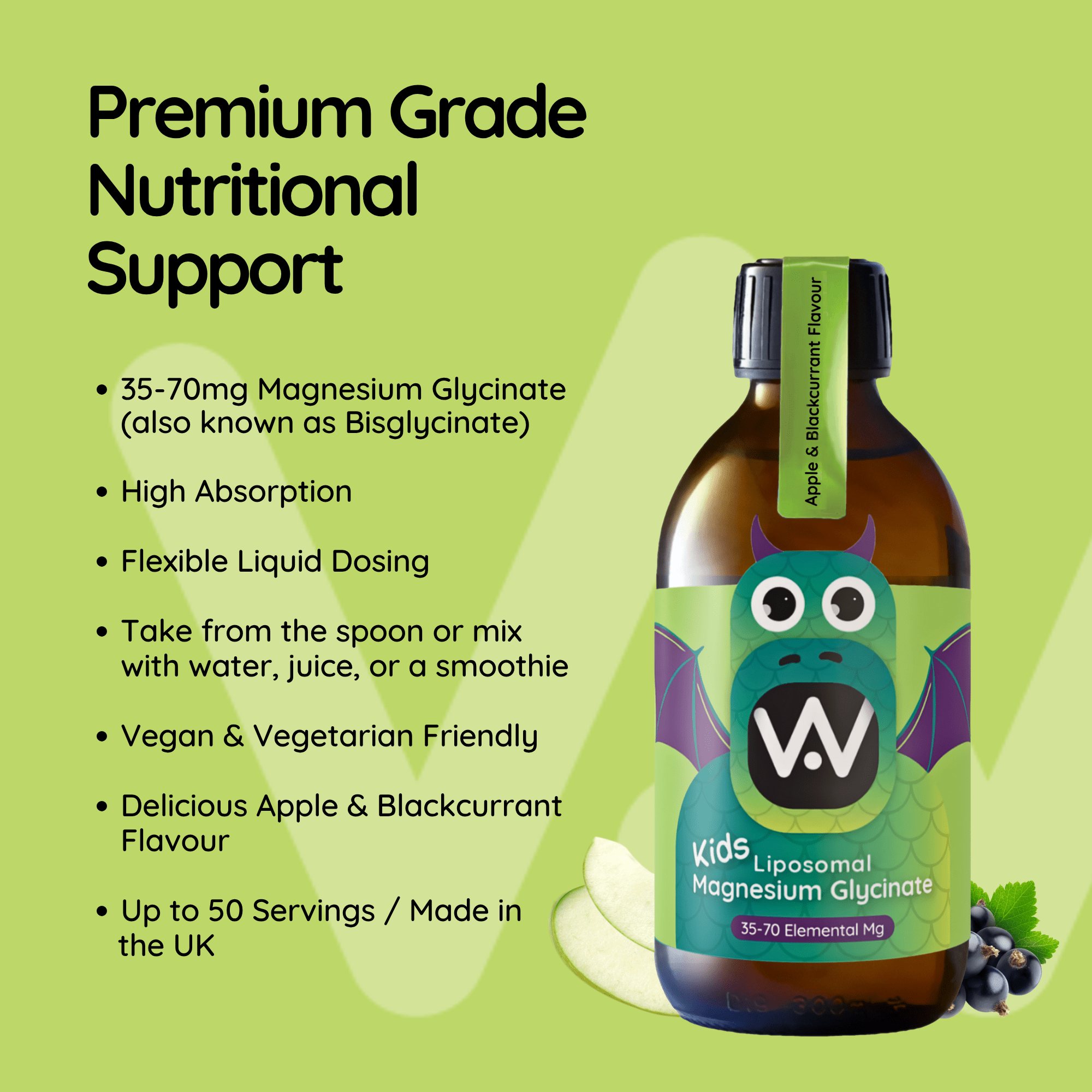
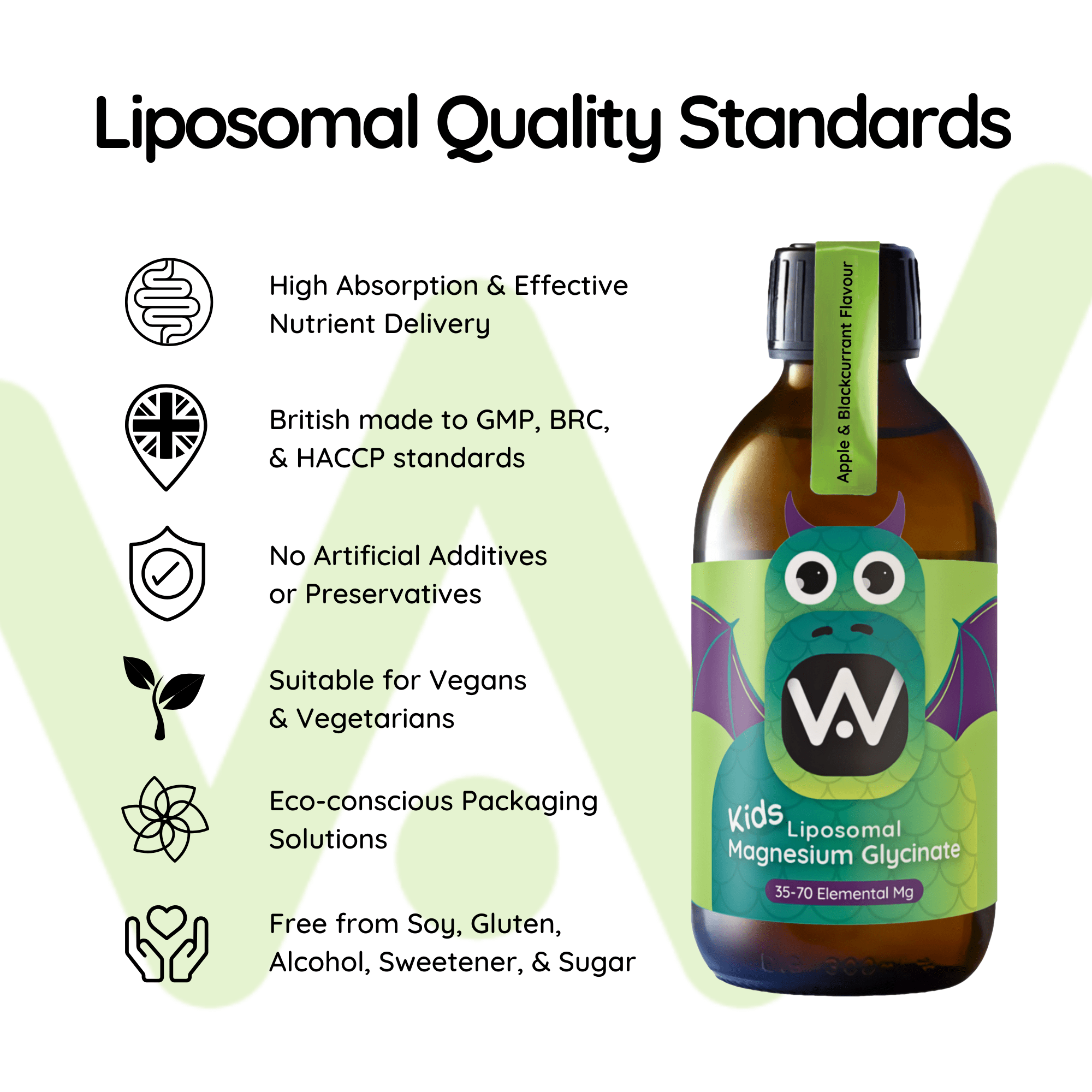
frequently.asked.questions.
How much Magnesium should I give my child?
It depends on their age and needs. Here’s a guide using our product’s dosing:
A 5ml serving provides 35mg of elemental magnesium, which is:
- 42% of the
recommended daily amount (DRV) for 2–3-year-olds - 29% for 4–6-year-olds
A 10ml serving provides 70mg of elemental magnesium, which is:
- 35% of the
recommended daily amount for 7–10-year-olds - 25% for 11–14-year-olds
Our liquid magnesium is designed for flexible dosing, so you can adjust the amount based on your child’s age, sensitivity, and needs. For younger children or those new to magnesium, you can start with a lower dose and build up gradually if needed. Always follow the label and check with a healthcare
professional if you're unsure.
Does Magnesium help children sleep?
Yes, magnesium supports the nervous system and helps regulate melatonin, the hormone that tells the body it’s time to sleep. Many parents find it helps their child fall asleep more easily and sleep more soundly.
What time should I give the magnesium?
We recommend giving magnesium 1-2 hours before bed. It can also be taken earlier in the evening, especially if it’s part of a wind-down routine.
How long does magnesium take to work?
Some children notice a calming effect within an hour, while others may take a few days to a week of consistent use to experience full benefits, especially for sleep or focus.
Can you have too much magnesium or become dependent?
Magnesium is an essential mineral, and the body regulates what it doesn’t need. Too much can sometimes cause loose stools or tummy upset, but toxicity from food or supplements is extremely rare.
Our children’s magnesium provides 35mg of elemental magnesium in 5ml (29–42% of the recommended daily intake depending on age) and 70mg in 10ml (25–35% depending on age). This means even at a full serving, your child is well within safe levels and not anywhere near excessive intake.
And no, your child won’t become dependent on magnesium. It simply supports natural processes like sleep, mood, and muscle relaxation rather than replacing them (responsible for over 300 reactions in the body!).
Why are there crystals in my Magnesium?
With our formula, crystallisation is rare, but it can occasionally happen around the inside rim of the bottle where the liquid meets air or when a little splashes up the sides, often during transport.
In simple terms, crystallisation is caused when the magnesium and liposomes, do not have enough water to hydrate it. When a small amount of liquid is exposed to air on the bottle’s side, it can dry and form a thin crystal layer. This is only ever on the surface, very minimal, and does not affect the quality, safety, or effectiveness of the rest of the formula.
Will Magnesium make a child drowsy or cause them to sleep in?
Magnesium helps children relax but doesn’t act like a sedative. It won’t knock them out or cause grogginess, It just supports better quality rest.
My child is under 2, Can they take this?
Please check with your GP or health practitioner before giving magnesium supplements to children under 2 years old.
Will Magnesium help my child who has ADHD or autism or is awaiting a diagnosis?
Research shows that children with ADHD, autism, and other neurodiverse conditions often have lower magnesium levels than their peers. Magnesium plays an important role in supporting the nervous system, calmness, focus, and better sleep, so ensuring good magnesium intake may be beneficial.
Many parents and some studies suggest that magnesium, along with nutrients like B vitamins, vitamin D, zinc, and omega-3s, can help support overall wellbeing in children with additional needs. However, every child is different, and supplements should never replace professional medical advice or treatment. If your child has a diagnosis or you are awaiting one, we always recommend speaking to your GP or specialist before starting a new supplement.
My child is sensitive to taste and smells. What isthis supplement like?
Our children’s magnesium comes in a delicious apple and blackcurrant flavour, specially chosen with fussy taste buds in mind. Of course, every childs taste buds are different, so we can’t guarantee they’ll all love it. If your child isn’t keen on the taste, you can simply mix it into their favourite drink, smoothie, or a little juice to make it easier to take. If you do mix it into a drink, we recommend your child consumes it within 30 minutes, as natural liposome separation can begin if left for longer than an hour.
Can I microwave this in my child’s milk? Or blend in a smoothie?
We don’t recommend microwaving, as heat can affect the stability of the nutrients. You can stir it into warm (not hot) milk or add it to a cold smoothie. If you’re making a blended smoothie, add the magnesium after blending, this helps protect the delicate liposomes, so your child gets the full benefit. If you do mix it into a drink, we recommend your child consumes it within 30 minutes, as natural liposome separation can begin if left for longer than an hour.
Can Magnesium be taken with other supplements?
Yes, magnesium can be taken alongside most vitamins and minerals, including vitamin C, B vitamins, vitamin D, and zinc. They work well together and won’t interfere with each other’s absorption. If your child is taking prescribed medication or a specialised supplement, it’s always best to check with your GP or healthcare professional first.
My child is suffering with anxiety. Would magnesium help?
Magnesium is known to support the nervous system and may help reduce feelings of worry or overwhelm by calming the brain and body. It’s a gentle, natural way to support emotional balance, but always speak to your GP if your childs anxiety is ongoing.
How long does the bottle keep once opened? Does it need to be stored in a fridge?
Once opened, the bottle should be used within 60 days. To keep the formula at its best, it must be stored in the fridge after opening.
Is this suitable for vegans?
Yes, all our supplements are 100% vegan.
What signs or symptoms show my child might be low in magnesium?
Some possible signs include:
- Restlessness or trouble sleeping
- Muscle cramps or twitches
- Anxiety or irritability
- Poor focus or fidgeting
- Fatigue
If you’re unsure, speak with a healthcare professional.
Are there any side effects of magnesium in kids?
Magnesium is generally very well tolerated in children. Occasionally, too much can cause loose stools or tummy upset. Just like with any supplement, there can be individual sensitivities, but this varies from child to child.
We specifically chose Magnesium Glycinate because it is one of the gentlest forms and is far less likely to cause the cramping or loose stools sometimes seen with other types, such as Magnesium Citrate.
That said, magnesium in any form has a mild osmotic laxative effect, this means it draws water into the intestines, which can naturally soften stools and make them easier to pass. This is very different from a stimulant laxative, which forces a bowel movement.
If you do notice any tummy upset, simply reduce the dose and build up gradually once your child is used to it.
Is your Magnesium third-party tested for quality and purity?
Absolutely. All our products are independently tested to ensure they meet the highest standards for safety, purity, and quality.
What are the key benefits of magnesium for children?
Magnesium supports:
- Better sleep
- Calmer mood
- Stronger bones and muscles
- Healthy brain and nervous system development
- More balanced energy and focus
Why is liposomal Magnesium better?
Magnesium on its own is an insoluble mineral, so it must be bound to another compound to be absorbed by the body. Some forms work better than others, for example, Magnesium Oxide has less than 4% absorption, with the rest being eliminated, and is mainly used for constipation.
At Well.Actually., we use Magnesium Glycinate, where magnesium is bound to two glycine amino acids. This form is gentler on the stomach and more bioavailable, with an absorption potential of around 30–50%. However, absorption can still vary depending on the digestive system and other factors. That’s why we go one step further and wrap our magnesium in liposomes.
Liposomes are tiny protective bubbles made from the same material as our cell membranes. They provide several advantages:
- Protection – Encapsulation shields magnesium as it passes through the stomach and intestines, preventing it from breaking down or interacting with other foods and medications.
- Absorption efficiency – Liposomes are absorbed via the lymphatic system, one of the most direct and efficient nutrient delivery routes. Non-encapsulated magnesium is still absorbed through normal pathways, but liposomal delivery ensures far greater uptake.
- Safer & gentler – By preventing direct contact with the gut lining, liposomes help reduce the risk of side effects like cramping or loose stools.
- Targeted delivery – Liposomes circulate in the blood for longer and merge with cell membranes, releasing magnesium directly into the cells where it’s needed most.
In short, liposomal magnesium means your child gets more of the magnesium you give them, in a form that’s gentler, more effective, and better absorbed than standard tablets, powders, or gummies.



